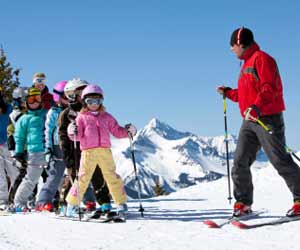Job Issues for Ski Instructors
Good ski and snowboard instructors enter and stay in the business primarily for two reasons: to become better skiers and boarders and to help others become better skiers and boarders. These two motivations must work together; neither one alone will keep you in the trade for long.
Despite what many people might think, the most important skills for an instructor to have are not necessarily outstanding technical abilities. As an instructor, you’ll need to help people get what they want from their mountain experience, but that help is not limited to providing technical instruction. Solid people skills are essential for success as a ski or snowboard instructor.

Working with People
The best instructors are those who genuinely like working with people, even when some of them may be tough to like. From the perspective of area management, instructors are the most visible representatives of the resort and so must always project a professional manner.
The successful instructor focuses on the satisfaction of the student as the ultimate goal. She enhances the student’s experience by providing structure, expertise, and good humor.
In the words of one ski school director:
“It’s good work. You’re on your board or your skis and you’re outside working with the public. It’s good fun.”
— View Ski Resort Job Postings —
Occasionally an instructor can become so involved in the technical aspects of his job that he loses sight of the student’s primary goal: to have fun.
Most people seeking instruction are not out to become Olympic-class skiers or extreme snowboarders. In fact many are merely interested in keeping themselves from breaking bones on the slopes.
Another segment of the instructor work force is those who teach children’s lessons. These positions often require very little skiing knowledge. Sometimes compared to being a babysitter or a camp counselor, the ability to work as a children’s instructor relies largely on being able to relate to children.
A children’s ski instructor told us about the work:
“For people who don’t know how to ski at all, this is a fine job. You get to play and have fun with the kids. You work out in this small area and you don’t have skis on yourself. You’re just teaching drills, so you don’t need any skiing skills. They help, though.”
Weather
An important reality of ski and snowboard instruction to keep in mind is that business depends on the weather: as long as snow conditions are good, customers will sign up for lessons. As the season winds down and the weather warms up, weekend warriors discover golf or tennis or that their lawns need weeding. Typically, your hours of teaching may be cut back, which means more free skiing or boarding; you may be laid off, which means a premature trip to the unemployment line; or you may be asked to load chairs, which means you get paid and you can work on your tan, but you don’t get to enjoy the slopes nearly as much as you did while you were instructing.
In addition, full-time ski school personnel are often drawn upon to represent the resort area at pre-season shows, promotions, special events, or races sponsored by the resorts.
Pay
Working as a ski or snowboard instructor has many valuable rewards, but pay is usually not one of the biggest. Each school has its own pay structure based on experience, hours spent teaching, and certification. On average, a first-year, non-certified instructor can expect to earn about $9.50 per hour. An experienced, fully certified instructor might be able to make $16 or $18 per hour. Keep in mind that most ski or snowboard instructors are only paid for hours spent actually teaching. Some instructors might earn tips, but it’s best not to count on it.
For most instructors, “request privates” are the best kind of classes to teach. The pay scale for private lessons is generally higher than class instruction and it’s an ego boost to have people specifically seeking your services. When former students return and pay premium prices for your time, you can bet it was due to your having left them smiling – in addition to having improved their turns.
Work Load
If you’re going to become a ski instructor know that work days can be long, starting with early morning setup of the meeting area. Walk-in student teaching assignments are distributed among instructors, and frequently teachers are held at the base area while waiting for sign-ups. This can be frustrating on beautiful days. After teaching anywhere from four to eight hours, instructors often may be required to attend teaching clinics for the last hour or two of the day. These clinics might be for exam prep or simply for instructor improvement.
If you are assigned preorganized classes, such as junior or senior high school groups, you may have to fill out evaluations on each student so that they can receive school credit for their time.
At the end of the work day, you might find time for a quick beer, dinner, and preparation for the next day’s classes before falling into bed. And don’t underestimate the physical demands of working in an environment of at- or below-freezing temperatures for four to five months.

